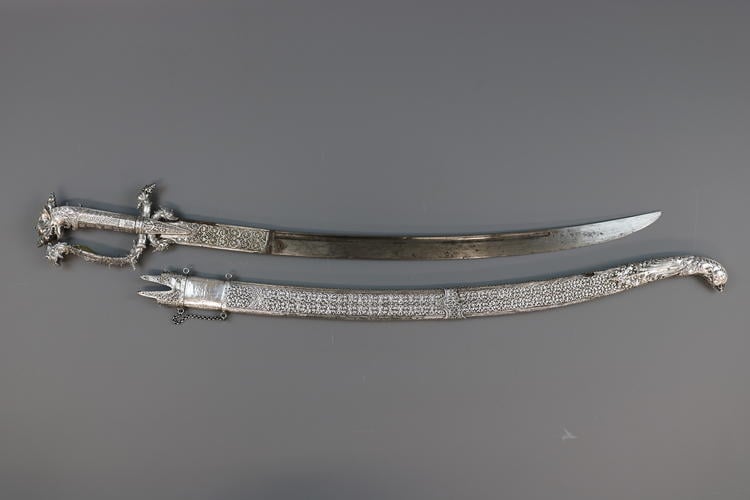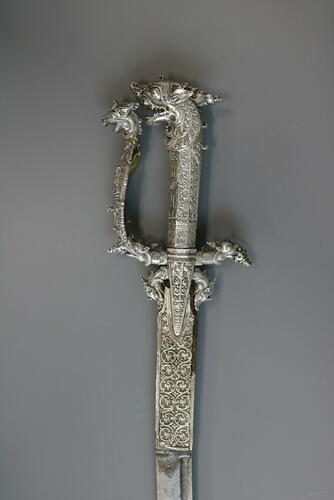-
1 of 253523 objects
Sword (kasthāné) and scabbard 1800-75
Steel and silver | 67.2 x 11.2 x 2.7 cm (whole object) | RCIN 11460

Sword (kasthāné) and scabbard 1800-75

Sword (kasthāné) and scabbard 1800-75


-
A sword (kasthāné) with a curved steel blade and silver fittings. The silver hilt has been cast and chased to create a Siṃha mūnu mitta, meaning "lion faced hilt" in Sinhala. The knuckle-guard (Ath häde) terminates in the carved head of a mythical bird, the sérapéṅdiya. The grip is shaped for the fingers, leading to an octagonal ferrule. The crossbar terminates in a sérapéṅdiya on one side, the other side has a makara head from which the knuckle-guard emerges, which in turn ends in another sérapéṅdiya head. On the front of the knuckle-guard is a figure of Lakshmi, goddess of abundance and fortune. She is sat in the lotus position, holding two sprays of vegetation. The quillons (vari sārkawa) take the form of two makara, their heads curving towards the base of the blade.
The blade is plain ferrous metal with a single fuller. The forte of the blade is decorated with embossed silver foil in the same repeating foliate patterns as the scabbard.
The wooden scabbard is covered in silver sheet, embossed with repeating foliate motifs. The scabbard finial is adorned with traditional curling elements (liya-pata). The scabbard mouth also has four loops and a fine chain.
This type of sword was associated with the royal courts of Kandy in Ceylon (modern-day Sri Lanka), where the workshops were known for their technical skills in metalworking. The King's workshop made silver examples like this one for his highest ranking officials, Adigar.
P. Dekker
P. E. P. Deraniyagala; Sinhala Weapons and Armor. The Journal of the Ceylon Branch of the Royal Asiatic Society, Volume XXXV, No. 95, part III. 7th December 1942. Pages 112-113.Provenance
Presented to King Edward VII, when Prince of Wales, during his tour of India in 1875-76 by the Chiefs of Kandy [Sri Lanka]
-
Medium and techniques
Steel and silver
Measurements
67.2 x 11.2 x 2.7 cm (whole object)